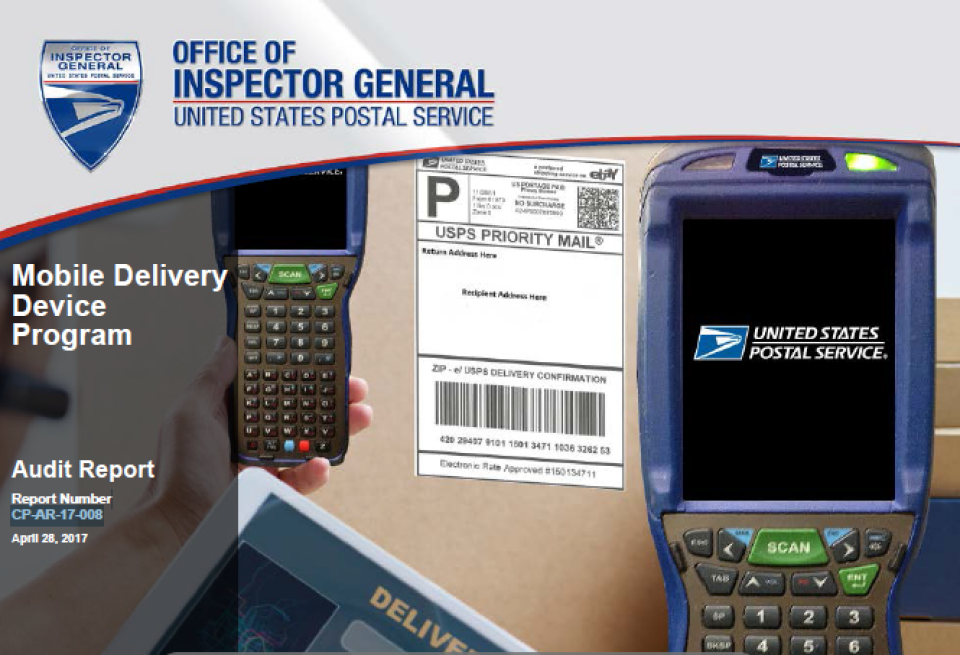Mobile Delivery Device Program
Background
Mobile Delivery Devices (MDD) are handheld scanners that replaced two existing, paired devices – the Intelligent Mail Devices and clamshell cell phones. Letter carriers use MDDs on the street to track package delivery in real time. This tracking capability, known as package visibility, is essential for the U.S. Postal Service to be competitive and increase package volume.
The Decision Analysis Report (DAR) Business Case is a document prepared by management to recommend an investment for approval. The DAR describes the problem or opportunity the expenditure will address. It must provide sufficient detail, including backup documentation, to enable the approving authorities to make an informed decision regarding the use of postal funds.
The Postal Service approved [redacted] million (including capital, investment and operating costs) to implement the MDD program. The DAR contained three performance metrics that were vital to the success of the program. MDD deployment started in September 2014 and was essentially completed in June 2016. The Postal Service has deployed 262,800 devices, software releases, and related accessories.
Our objective was to assess whether the Postal Service achieved the performance metrics, savings, and costs identified in the DAR.
What the OIG Found
Opportunities exist to improve the MDD program. The MDD program has improved package visibility and achieved a key metric: reducing Intelligent Mail Device repair and help desk costs by [redacted] million for fiscal year 2016. However, the Postal Service did not achieve two of the three key performance metrics identified in the DAR: (1) average time to post delivery scan data to the tracking system is less than [redacted] and (2) [redacted] percent of scans posted to the tracking system are within [redacted]. Specifically, between November 2016 and January 2017, the average time to post delivery scans was [redacted] minutes. Also, [redacted] of [redacted] billion ([redacted] percent) of delivery scan data was posted in less than [redacted].
Factors that affected the posting time included system network connectivity issues and MDD conditions, such as screens freezing and laser beam readers malfunctioning. Inadequate network connectivity and MDD conditions can reduce customer satisfaction, increasing the risk customers may consider alternative package delivery providers.
Also, the Postal Service paid $[redacted] million for batteries that did not consistently support continuous operation of the MDDs. Additional functionalities were added to the MDD after deployment. Management did not include these additional functionalities in the contract; therefore, they did not accurately project battery life needs. The shorter-than-required battery life and other functionality issues caused letter carriers to use ineffective and inefficient workarounds, which could increase delivery route time or cause customers to receive incorrect or delayed delivery information.
In addition, the Postal Service did not track delivery-related savings of [redacted] million. This amount was presented as a potential savings opportunity in the DAR justification section and not in the cash flow statement report. Management stated that they are only required to track financial information in the cash flow. Accordingly, we were unable to verify the projected savings opportunities for the MDD program. We believe information not included in the cash flow should be tracked and evaluated post-implementation.
The DAR is used to make strategic business decisions regarding significant investments in infrastructure. If those tasked with approving and evaluating the DAR cannot be assured the data supplied by those requesting such investments is reasonable and accurate, there is an increased risk of poor business decisions. By monitoring costs and savings supported with verified data, DAR stakeholders can make informed investment decisions and evaluate the success or impact of investments post-implementation.
The Postal Service was tracking the capital and expense investment costs. As of November 2016, the Postal Service had spent [redacted] million ([redacted] percent) of the $[redacted] million of the projected capital and expense investment costs in the DAR. The Postal Service estimates it will have expended 70 percent of the capital and expense investment costs when the project is completed in fiscal year 2017.
What the OIG Recommended
We recommended management include descriptions or explanations in the weekly status reports for all known issues related to Mobile Delivery Device network connectivity and functionality.
We also recommended management communicate with the vendor to resolve the battery life issues.
In addition, we recommended management revise Handbook F-66, General Investment Policies and Procedures, to require program sponsors to track estimated savings opportunities in the DAR, in the same manner as tracking financial information in the cash flow.

